CHCECE004: Promote and Provide Healthy Food and Drinks Assignment
VerifiedAdded on 2023/01/09
|22
|6327
|1
Homework Assignment
AI Summary
This assignment, focusing on the CHCECE004 unit, addresses the crucial aspects of promoting and providing healthy food and drinks in early childhood education. It starts with short answer questions covering food safety standards, storage practices, and the requirements of the National Quality Standard (NQS) regarding healthy eating. The assignment delves into the National Education and Care Services Regulation, detailing requirements for food and beverage provision, including weekly menu guidelines. It explores the significance of dietary fats for infants, the introduction of solid foods, and the appropriate food types for different age groups. The assessment also covers the five food groups and their nutritional contributions, along with the components of a balanced menu to meet children's daily nutritional needs. The assignment underscores the importance of providing nutritious food and drinks in educational settings to support children's health and development.
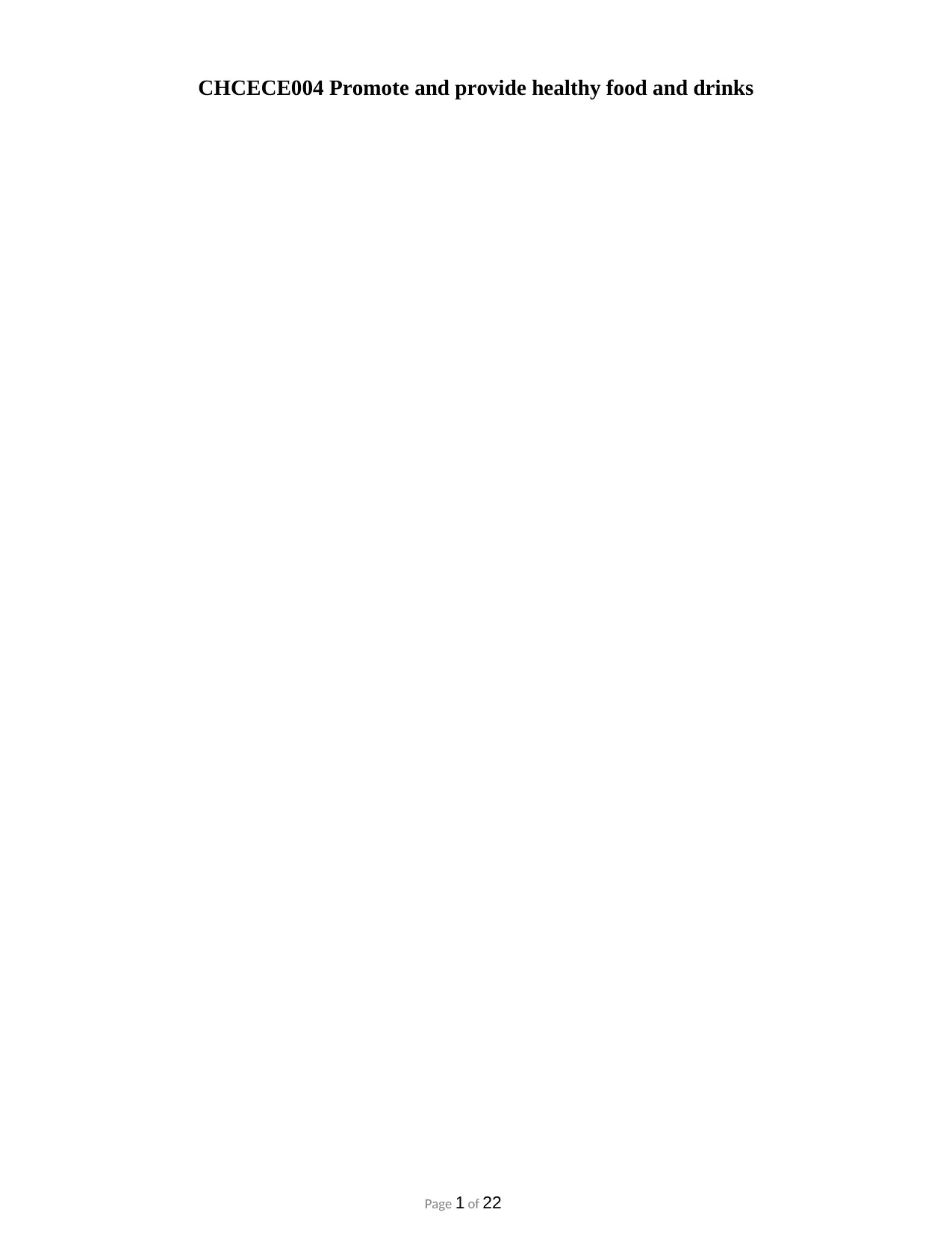
CHCECE004 Promote and provide healthy food and drinks
Page 1 of 22
Page 1 of 22
Paraphrase This Document
Need a fresh take? Get an instant paraphrase of this document with our AI Paraphraser
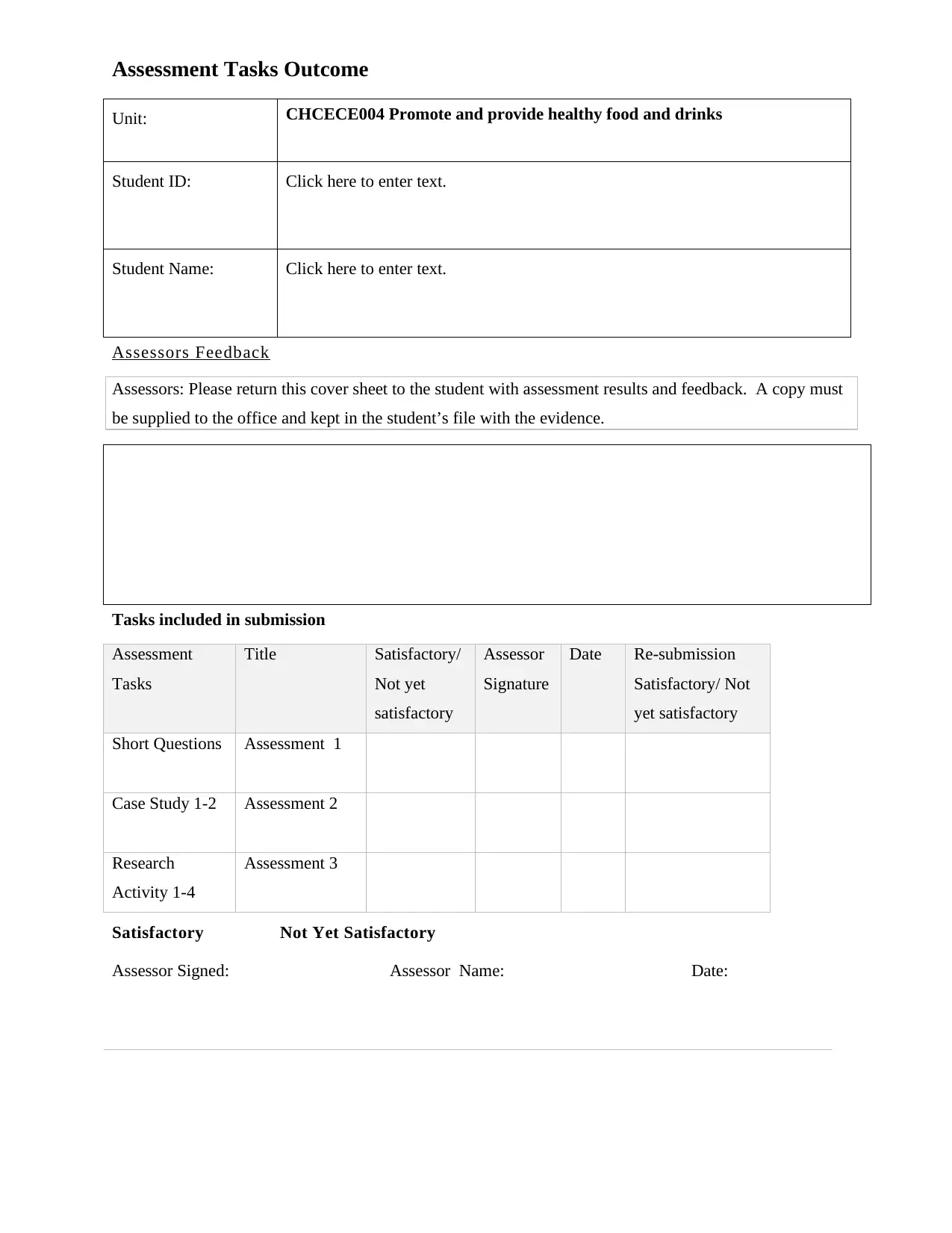
Assessment Tasks Outcome
Unit: CHCECE004 Promote and provide healthy food and drinks
Student ID: Click here to enter text.
Student Name: Click here to enter text.
Assessors Feedback
Assessors: Please return this cover sheet to the student with assessment results and feedback. A copy must
be supplied to the office and kept in the student’s file with the evidence.
Tasks included in submission
Assessment
Tasks
Title Satisfactory/
Not yet
satisfactory
Assessor
Signature
Date Re-submission
Satisfactory/ Not
yet satisfactory
Short Questions Assessment 1
Case Study 1-2 Assessment 2
Research
Activity 1-4
Assessment 3
Satisfactory Not Yet Satisfactory
Assessor Signed: Assessor Name: Date:
Unit: CHCECE004 Promote and provide healthy food and drinks
Student ID: Click here to enter text.
Student Name: Click here to enter text.
Assessors Feedback
Assessors: Please return this cover sheet to the student with assessment results and feedback. A copy must
be supplied to the office and kept in the student’s file with the evidence.
Tasks included in submission
Assessment
Tasks
Title Satisfactory/
Not yet
satisfactory
Assessor
Signature
Date Re-submission
Satisfactory/ Not
yet satisfactory
Short Questions Assessment 1
Case Study 1-2 Assessment 2
Research
Activity 1-4
Assessment 3
Satisfactory Not Yet Satisfactory
Assessor Signed: Assessor Name: Date:

Page left intentionally blank
Page 3 of 22
Page 3 of 22
⊘ This is a preview!⊘
Do you want full access?
Subscribe today to unlock all pages.

Trusted by 1+ million students worldwide
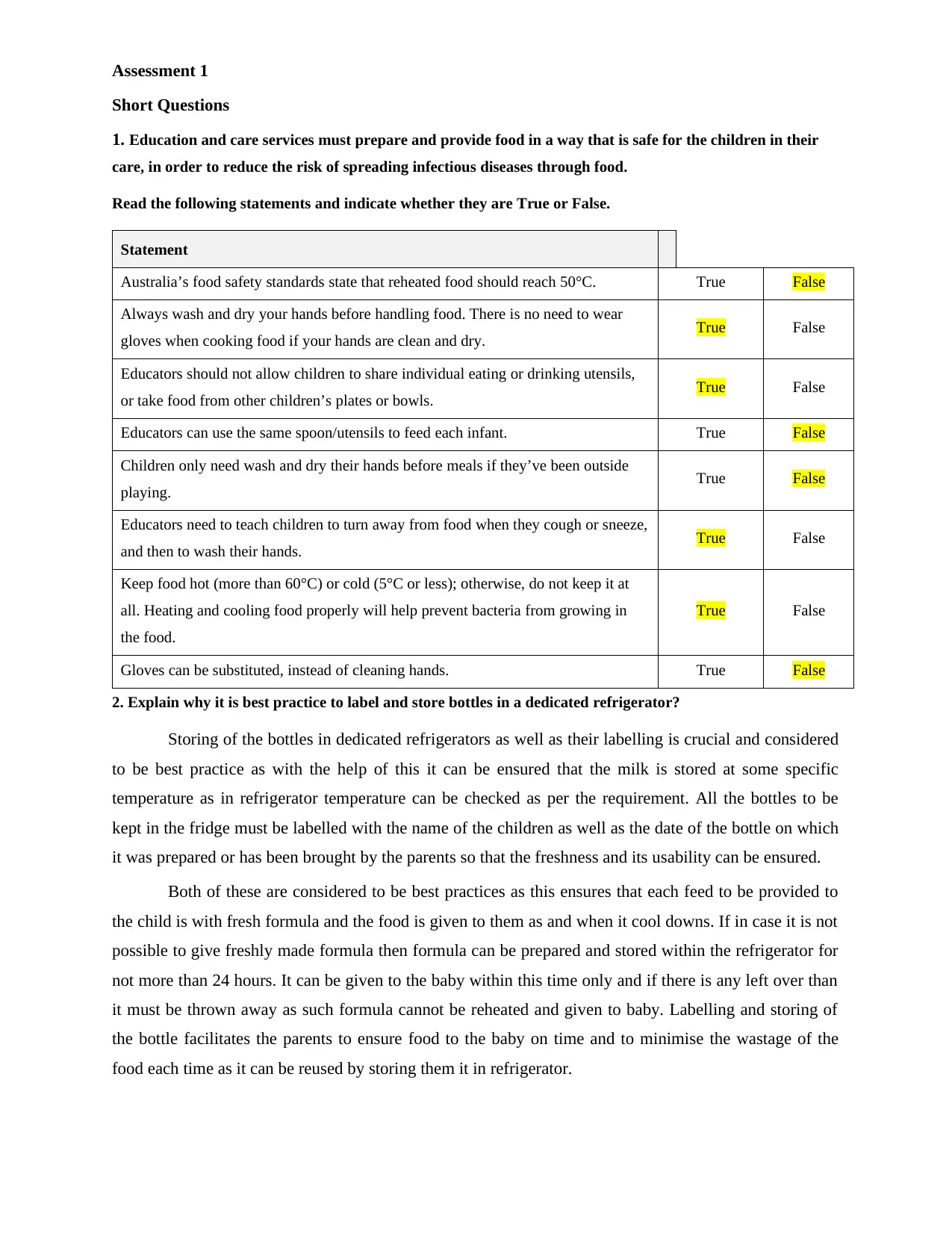
Assessment 1
Short Questions
1. Education and care services must prepare and provide food in a way that is safe for the children in their
care, in order to reduce the risk of spreading infectious diseases through food.
Read the following statements and indicate whether they are True or False.
Statement
Australia’s food safety standards state that reheated food should reach 50°C. True False
Always wash and dry your hands before handling food. There is no need to wear
gloves when cooking food if your hands are clean and dry. True False
Educators should not allow children to share individual eating or drinking utensils,
or take food from other children’s plates or bowls. True False
Educators can use the same spoon/utensils to feed each infant. True False
Children only need wash and dry their hands before meals if they’ve been outside
playing. True False
Educators need to teach children to turn away from food when they cough or sneeze,
and then to wash their hands. True False
Keep food hot (more than 60°C) or cold (5°C or less); otherwise, do not keep it at
all. Heating and cooling food properly will help prevent bacteria from growing in
the food.
True False
Gloves can be substituted, instead of cleaning hands. True False
2. Explain why it is best practice to label and store bottles in a dedicated refrigerator?
Storing of the bottles in dedicated refrigerators as well as their labelling is crucial and considered
to be best practice as with the help of this it can be ensured that the milk is stored at some specific
temperature as in refrigerator temperature can be checked as per the requirement. All the bottles to be
kept in the fridge must be labelled with the name of the children as well as the date of the bottle on which
it was prepared or has been brought by the parents so that the freshness and its usability can be ensured.
Both of these are considered to be best practices as this ensures that each feed to be provided to
the child is with fresh formula and the food is given to them as and when it cool downs. If in case it is not
possible to give freshly made formula then formula can be prepared and stored within the refrigerator for
not more than 24 hours. It can be given to the baby within this time only and if there is any left over than
it must be thrown away as such formula cannot be reheated and given to baby. Labelling and storing of
the bottle facilitates the parents to ensure food to the baby on time and to minimise the wastage of the
food each time as it can be reused by storing them it in refrigerator.
Short Questions
1. Education and care services must prepare and provide food in a way that is safe for the children in their
care, in order to reduce the risk of spreading infectious diseases through food.
Read the following statements and indicate whether they are True or False.
Statement
Australia’s food safety standards state that reheated food should reach 50°C. True False
Always wash and dry your hands before handling food. There is no need to wear
gloves when cooking food if your hands are clean and dry. True False
Educators should not allow children to share individual eating or drinking utensils,
or take food from other children’s plates or bowls. True False
Educators can use the same spoon/utensils to feed each infant. True False
Children only need wash and dry their hands before meals if they’ve been outside
playing. True False
Educators need to teach children to turn away from food when they cough or sneeze,
and then to wash their hands. True False
Keep food hot (more than 60°C) or cold (5°C or less); otherwise, do not keep it at
all. Heating and cooling food properly will help prevent bacteria from growing in
the food.
True False
Gloves can be substituted, instead of cleaning hands. True False
2. Explain why it is best practice to label and store bottles in a dedicated refrigerator?
Storing of the bottles in dedicated refrigerators as well as their labelling is crucial and considered
to be best practice as with the help of this it can be ensured that the milk is stored at some specific
temperature as in refrigerator temperature can be checked as per the requirement. All the bottles to be
kept in the fridge must be labelled with the name of the children as well as the date of the bottle on which
it was prepared or has been brought by the parents so that the freshness and its usability can be ensured.
Both of these are considered to be best practices as this ensures that each feed to be provided to
the child is with fresh formula and the food is given to them as and when it cool downs. If in case it is not
possible to give freshly made formula then formula can be prepared and stored within the refrigerator for
not more than 24 hours. It can be given to the baby within this time only and if there is any left over than
it must be thrown away as such formula cannot be reheated and given to baby. Labelling and storing of
the bottle facilitates the parents to ensure food to the baby on time and to minimise the wastage of the
food each time as it can be reused by storing them it in refrigerator.
Paraphrase This Document
Need a fresh take? Get an instant paraphrase of this document with our AI Paraphraser
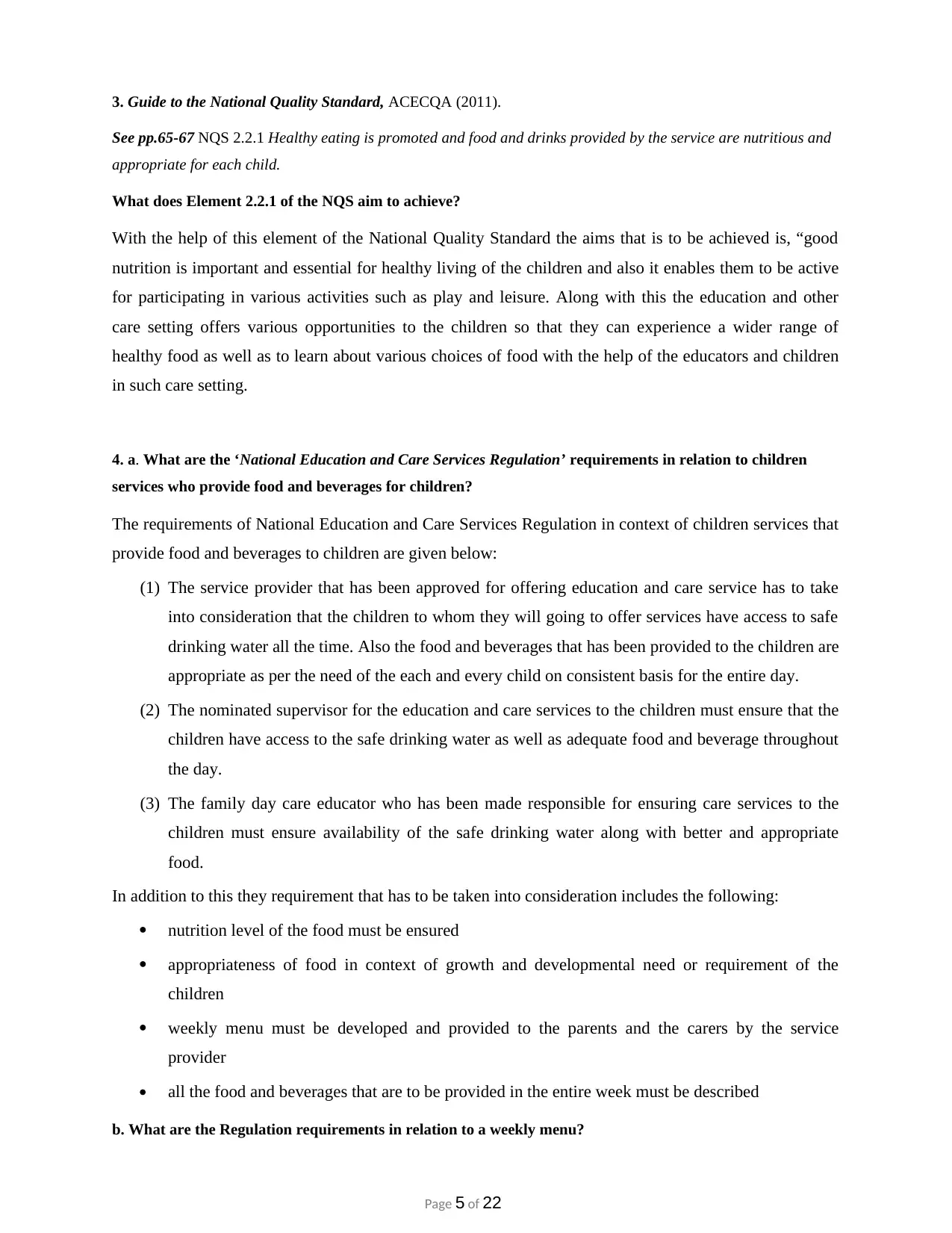
3. Guide to the National Quality Standard, ACECQA (2011).
See pp.65-67 NQS 2.2.1 Healthy eating is promoted and food and drinks provided by the service are nutritious and
appropriate for each child.
What does Element 2.2.1 of the NQS aim to achieve?
With the help of this element of the National Quality Standard the aims that is to be achieved is, “good
nutrition is important and essential for healthy living of the children and also it enables them to be active
for participating in various activities such as play and leisure. Along with this the education and other
care setting offers various opportunities to the children so that they can experience a wider range of
healthy food as well as to learn about various choices of food with the help of the educators and children
in such care setting.
4. a. What are the ‘National Education and Care Services Regulation’ requirements in relation to children
services who provide food and beverages for children?
The requirements of National Education and Care Services Regulation in context of children services that
provide food and beverages to children are given below:
(1) The service provider that has been approved for offering education and care service has to take
into consideration that the children to whom they will going to offer services have access to safe
drinking water all the time. Also the food and beverages that has been provided to the children are
appropriate as per the need of the each and every child on consistent basis for the entire day.
(2) The nominated supervisor for the education and care services to the children must ensure that the
children have access to the safe drinking water as well as adequate food and beverage throughout
the day.
(3) The family day care educator who has been made responsible for ensuring care services to the
children must ensure availability of the safe drinking water along with better and appropriate
food.
In addition to this they requirement that has to be taken into consideration includes the following:
nutrition level of the food must be ensured
appropriateness of food in context of growth and developmental need or requirement of the
children
weekly menu must be developed and provided to the parents and the carers by the service
provider
all the food and beverages that are to be provided in the entire week must be described
b. What are the Regulation requirements in relation to a weekly menu?
Page 5 of 22
See pp.65-67 NQS 2.2.1 Healthy eating is promoted and food and drinks provided by the service are nutritious and
appropriate for each child.
What does Element 2.2.1 of the NQS aim to achieve?
With the help of this element of the National Quality Standard the aims that is to be achieved is, “good
nutrition is important and essential for healthy living of the children and also it enables them to be active
for participating in various activities such as play and leisure. Along with this the education and other
care setting offers various opportunities to the children so that they can experience a wider range of
healthy food as well as to learn about various choices of food with the help of the educators and children
in such care setting.
4. a. What are the ‘National Education and Care Services Regulation’ requirements in relation to children
services who provide food and beverages for children?
The requirements of National Education and Care Services Regulation in context of children services that
provide food and beverages to children are given below:
(1) The service provider that has been approved for offering education and care service has to take
into consideration that the children to whom they will going to offer services have access to safe
drinking water all the time. Also the food and beverages that has been provided to the children are
appropriate as per the need of the each and every child on consistent basis for the entire day.
(2) The nominated supervisor for the education and care services to the children must ensure that the
children have access to the safe drinking water as well as adequate food and beverage throughout
the day.
(3) The family day care educator who has been made responsible for ensuring care services to the
children must ensure availability of the safe drinking water along with better and appropriate
food.
In addition to this they requirement that has to be taken into consideration includes the following:
nutrition level of the food must be ensured
appropriateness of food in context of growth and developmental need or requirement of the
children
weekly menu must be developed and provided to the parents and the carers by the service
provider
all the food and beverages that are to be provided in the entire week must be described
b. What are the Regulation requirements in relation to a weekly menu?
Page 5 of 22
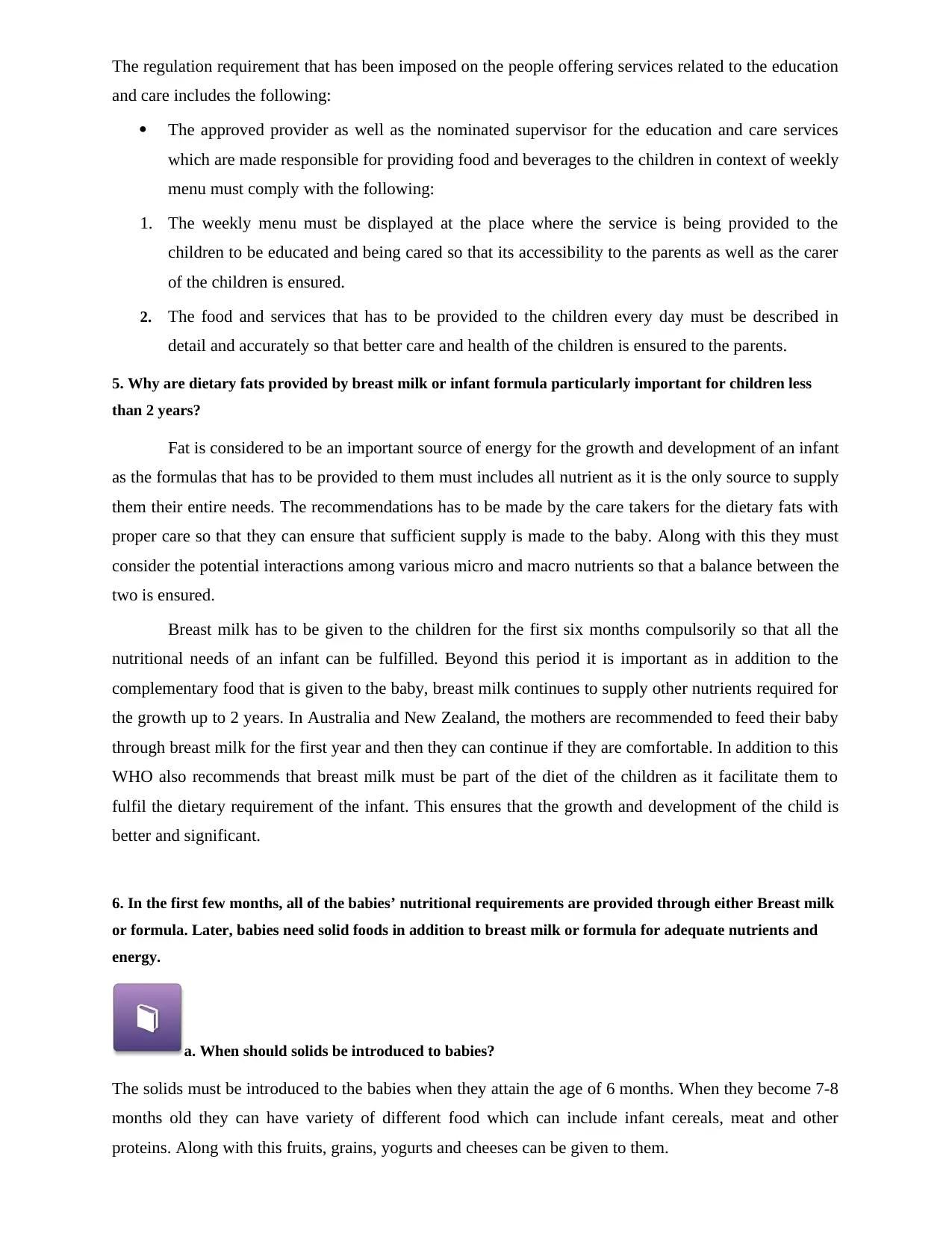
The regulation requirement that has been imposed on the people offering services related to the education
and care includes the following:
The approved provider as well as the nominated supervisor for the education and care services
which are made responsible for providing food and beverages to the children in context of weekly
menu must comply with the following:
1. The weekly menu must be displayed at the place where the service is being provided to the
children to be educated and being cared so that its accessibility to the parents as well as the carer
of the children is ensured.
2. The food and services that has to be provided to the children every day must be described in
detail and accurately so that better care and health of the children is ensured to the parents.
5. Why are dietary fats provided by breast milk or infant formula particularly important for children less
than 2 years?
Fat is considered to be an important source of energy for the growth and development of an infant
as the formulas that has to be provided to them must includes all nutrient as it is the only source to supply
them their entire needs. The recommendations has to be made by the care takers for the dietary fats with
proper care so that they can ensure that sufficient supply is made to the baby. Along with this they must
consider the potential interactions among various micro and macro nutrients so that a balance between the
two is ensured.
Breast milk has to be given to the children for the first six months compulsorily so that all the
nutritional needs of an infant can be fulfilled. Beyond this period it is important as in addition to the
complementary food that is given to the baby, breast milk continues to supply other nutrients required for
the growth up to 2 years. In Australia and New Zealand, the mothers are recommended to feed their baby
through breast milk for the first year and then they can continue if they are comfortable. In addition to this
WHO also recommends that breast milk must be part of the diet of the children as it facilitate them to
fulfil the dietary requirement of the infant. This ensures that the growth and development of the child is
better and significant.
6. In the first few months, all of the babies’ nutritional requirements are provided through either Breast milk
or formula. Later, babies need solid foods in addition to breast milk or formula for adequate nutrients and
energy.
a. When should solids be introduced to babies?
The solids must be introduced to the babies when they attain the age of 6 months. When they become 7-8
months old they can have variety of different food which can include infant cereals, meat and other
proteins. Along with this fruits, grains, yogurts and cheeses can be given to them.
and care includes the following:
The approved provider as well as the nominated supervisor for the education and care services
which are made responsible for providing food and beverages to the children in context of weekly
menu must comply with the following:
1. The weekly menu must be displayed at the place where the service is being provided to the
children to be educated and being cared so that its accessibility to the parents as well as the carer
of the children is ensured.
2. The food and services that has to be provided to the children every day must be described in
detail and accurately so that better care and health of the children is ensured to the parents.
5. Why are dietary fats provided by breast milk or infant formula particularly important for children less
than 2 years?
Fat is considered to be an important source of energy for the growth and development of an infant
as the formulas that has to be provided to them must includes all nutrient as it is the only source to supply
them their entire needs. The recommendations has to be made by the care takers for the dietary fats with
proper care so that they can ensure that sufficient supply is made to the baby. Along with this they must
consider the potential interactions among various micro and macro nutrients so that a balance between the
two is ensured.
Breast milk has to be given to the children for the first six months compulsorily so that all the
nutritional needs of an infant can be fulfilled. Beyond this period it is important as in addition to the
complementary food that is given to the baby, breast milk continues to supply other nutrients required for
the growth up to 2 years. In Australia and New Zealand, the mothers are recommended to feed their baby
through breast milk for the first year and then they can continue if they are comfortable. In addition to this
WHO also recommends that breast milk must be part of the diet of the children as it facilitate them to
fulfil the dietary requirement of the infant. This ensures that the growth and development of the child is
better and significant.
6. In the first few months, all of the babies’ nutritional requirements are provided through either Breast milk
or formula. Later, babies need solid foods in addition to breast milk or formula for adequate nutrients and
energy.
a. When should solids be introduced to babies?
The solids must be introduced to the babies when they attain the age of 6 months. When they become 7-8
months old they can have variety of different food which can include infant cereals, meat and other
proteins. Along with this fruits, grains, yogurts and cheeses can be given to them.
⊘ This is a preview!⊘
Do you want full access?
Subscribe today to unlock all pages.

Trusted by 1+ million students worldwide
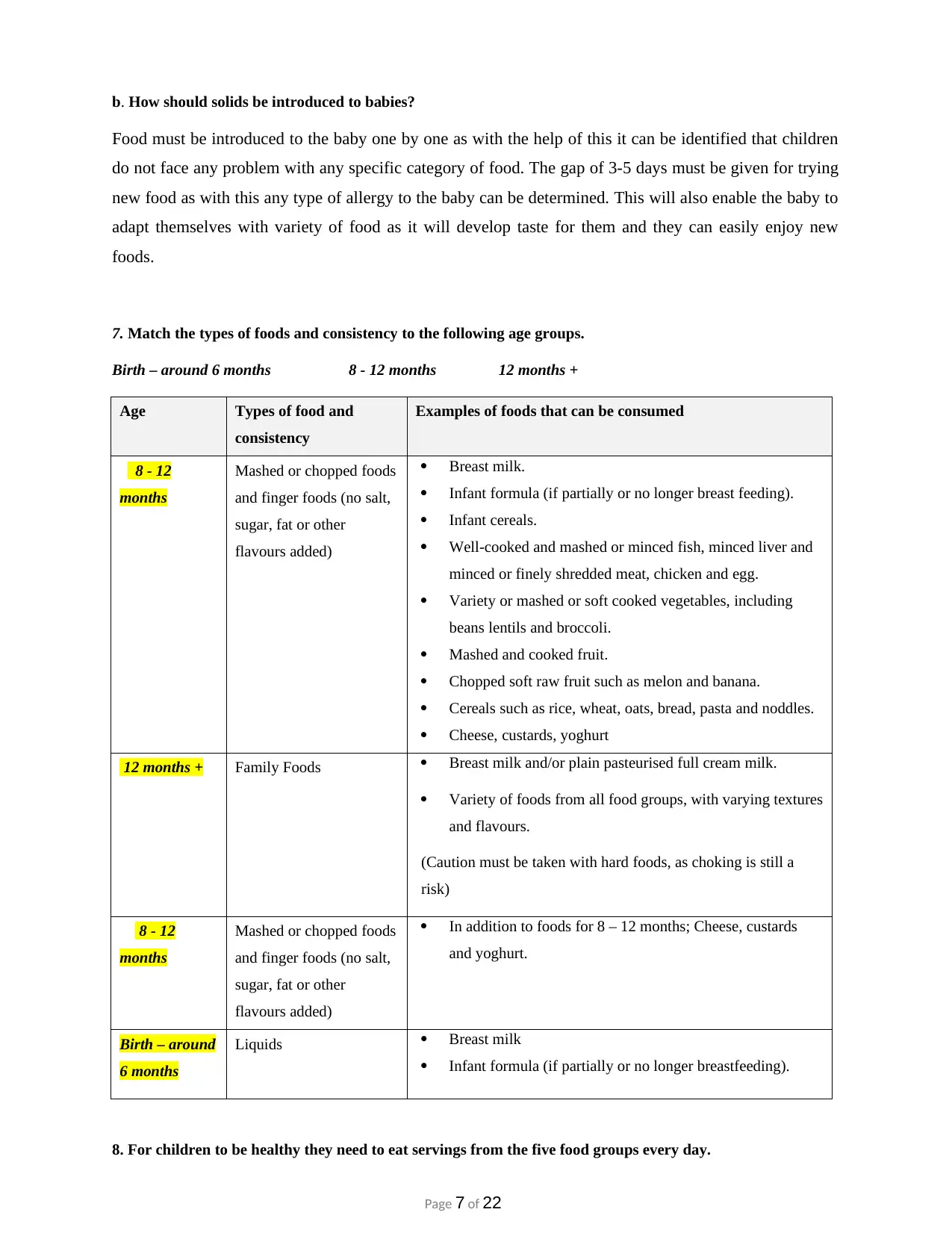
b. How should solids be introduced to babies?
Food must be introduced to the baby one by one as with the help of this it can be identified that children
do not face any problem with any specific category of food. The gap of 3-5 days must be given for trying
new food as with this any type of allergy to the baby can be determined. This will also enable the baby to
adapt themselves with variety of food as it will develop taste for them and they can easily enjoy new
foods.
7. Match the types of foods and consistency to the following age groups.
Birth – around 6 months 8 - 12 months 12 months +
Age Types of food and
consistency
Examples of foods that can be consumed
8 - 12
months
Mashed or chopped foods
and finger foods (no salt,
sugar, fat or other
flavours added)
Breast milk.
Infant formula (if partially or no longer breast feeding).
Infant cereals.
Well-cooked and mashed or minced fish, minced liver and
minced or finely shredded meat, chicken and egg.
Variety or mashed or soft cooked vegetables, including
beans lentils and broccoli.
Mashed and cooked fruit.
Chopped soft raw fruit such as melon and banana.
Cereals such as rice, wheat, oats, bread, pasta and noddles.
Cheese, custards, yoghurt
12 months + Family Foods Breast milk and/or plain pasteurised full cream milk.
Variety of foods from all food groups, with varying textures
and flavours.
(Caution must be taken with hard foods, as choking is still a
risk)
8 - 12
months
Mashed or chopped foods
and finger foods (no salt,
sugar, fat or other
flavours added)
In addition to foods for 8 – 12 months; Cheese, custards
and yoghurt.
Birth – around
6 months
Liquids Breast milk
Infant formula (if partially or no longer breastfeeding).
8. For children to be healthy they need to eat servings from the five food groups every day.
Page 7 of 22
Food must be introduced to the baby one by one as with the help of this it can be identified that children
do not face any problem with any specific category of food. The gap of 3-5 days must be given for trying
new food as with this any type of allergy to the baby can be determined. This will also enable the baby to
adapt themselves with variety of food as it will develop taste for them and they can easily enjoy new
foods.
7. Match the types of foods and consistency to the following age groups.
Birth – around 6 months 8 - 12 months 12 months +
Age Types of food and
consistency
Examples of foods that can be consumed
8 - 12
months
Mashed or chopped foods
and finger foods (no salt,
sugar, fat or other
flavours added)
Breast milk.
Infant formula (if partially or no longer breast feeding).
Infant cereals.
Well-cooked and mashed or minced fish, minced liver and
minced or finely shredded meat, chicken and egg.
Variety or mashed or soft cooked vegetables, including
beans lentils and broccoli.
Mashed and cooked fruit.
Chopped soft raw fruit such as melon and banana.
Cereals such as rice, wheat, oats, bread, pasta and noddles.
Cheese, custards, yoghurt
12 months + Family Foods Breast milk and/or plain pasteurised full cream milk.
Variety of foods from all food groups, with varying textures
and flavours.
(Caution must be taken with hard foods, as choking is still a
risk)
8 - 12
months
Mashed or chopped foods
and finger foods (no salt,
sugar, fat or other
flavours added)
In addition to foods for 8 – 12 months; Cheese, custards
and yoghurt.
Birth – around
6 months
Liquids Breast milk
Infant formula (if partially or no longer breastfeeding).
8. For children to be healthy they need to eat servings from the five food groups every day.
Page 7 of 22
Paraphrase This Document
Need a fresh take? Get an instant paraphrase of this document with our AI Paraphraser
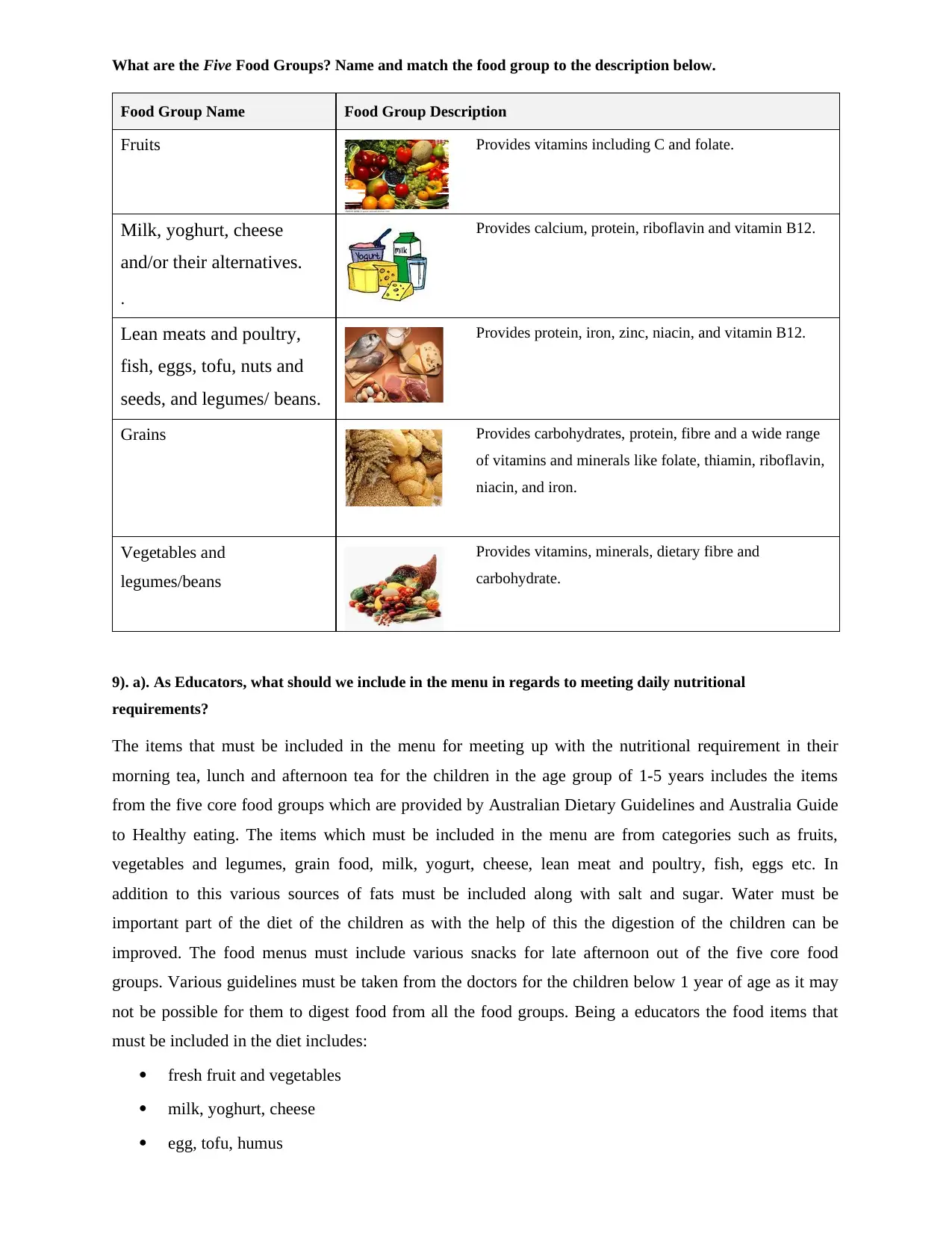
What are the Five Food Groups? Name and match the food group to the description below.
Food Group Name Food Group Description
Fruits Provides vitamins including C and folate.
Milk, yoghurt, cheese
and/or their alternatives.
.
Provides calcium, protein, riboflavin and vitamin B12.
Lean meats and poultry,
fish, eggs, tofu, nuts and
seeds, and legumes/ beans.
Provides protein, iron, zinc, niacin, and vitamin B12.
Grains Provides carbohydrates, protein, fibre and a wide range
of vitamins and minerals like folate, thiamin, riboflavin,
niacin, and iron.
Vegetables and
legumes/beans
Provides vitamins, minerals, dietary fibre and
carbohydrate.
9). a). As Educators, what should we include in the menu in regards to meeting daily nutritional
requirements?
The items that must be included in the menu for meeting up with the nutritional requirement in their
morning tea, lunch and afternoon tea for the children in the age group of 1-5 years includes the items
from the five core food groups which are provided by Australian Dietary Guidelines and Australia Guide
to Healthy eating. The items which must be included in the menu are from categories such as fruits,
vegetables and legumes, grain food, milk, yogurt, cheese, lean meat and poultry, fish, eggs etc. In
addition to this various sources of fats must be included along with salt and sugar. Water must be
important part of the diet of the children as with the help of this the digestion of the children can be
improved. The food menus must include various snacks for late afternoon out of the five core food
groups. Various guidelines must be taken from the doctors for the children below 1 year of age as it may
not be possible for them to digest food from all the food groups. Being a educators the food items that
must be included in the diet includes:
fresh fruit and vegetables
milk, yoghurt, cheese
egg, tofu, humus
Food Group Name Food Group Description
Fruits Provides vitamins including C and folate.
Milk, yoghurt, cheese
and/or their alternatives.
.
Provides calcium, protein, riboflavin and vitamin B12.
Lean meats and poultry,
fish, eggs, tofu, nuts and
seeds, and legumes/ beans.
Provides protein, iron, zinc, niacin, and vitamin B12.
Grains Provides carbohydrates, protein, fibre and a wide range
of vitamins and minerals like folate, thiamin, riboflavin,
niacin, and iron.
Vegetables and
legumes/beans
Provides vitamins, minerals, dietary fibre and
carbohydrate.
9). a). As Educators, what should we include in the menu in regards to meeting daily nutritional
requirements?
The items that must be included in the menu for meeting up with the nutritional requirement in their
morning tea, lunch and afternoon tea for the children in the age group of 1-5 years includes the items
from the five core food groups which are provided by Australian Dietary Guidelines and Australia Guide
to Healthy eating. The items which must be included in the menu are from categories such as fruits,
vegetables and legumes, grain food, milk, yogurt, cheese, lean meat and poultry, fish, eggs etc. In
addition to this various sources of fats must be included along with salt and sugar. Water must be
important part of the diet of the children as with the help of this the digestion of the children can be
improved. The food menus must include various snacks for late afternoon out of the five core food
groups. Various guidelines must be taken from the doctors for the children below 1 year of age as it may
not be possible for them to digest food from all the food groups. Being a educators the food items that
must be included in the diet includes:
fresh fruit and vegetables
milk, yoghurt, cheese
egg, tofu, humus
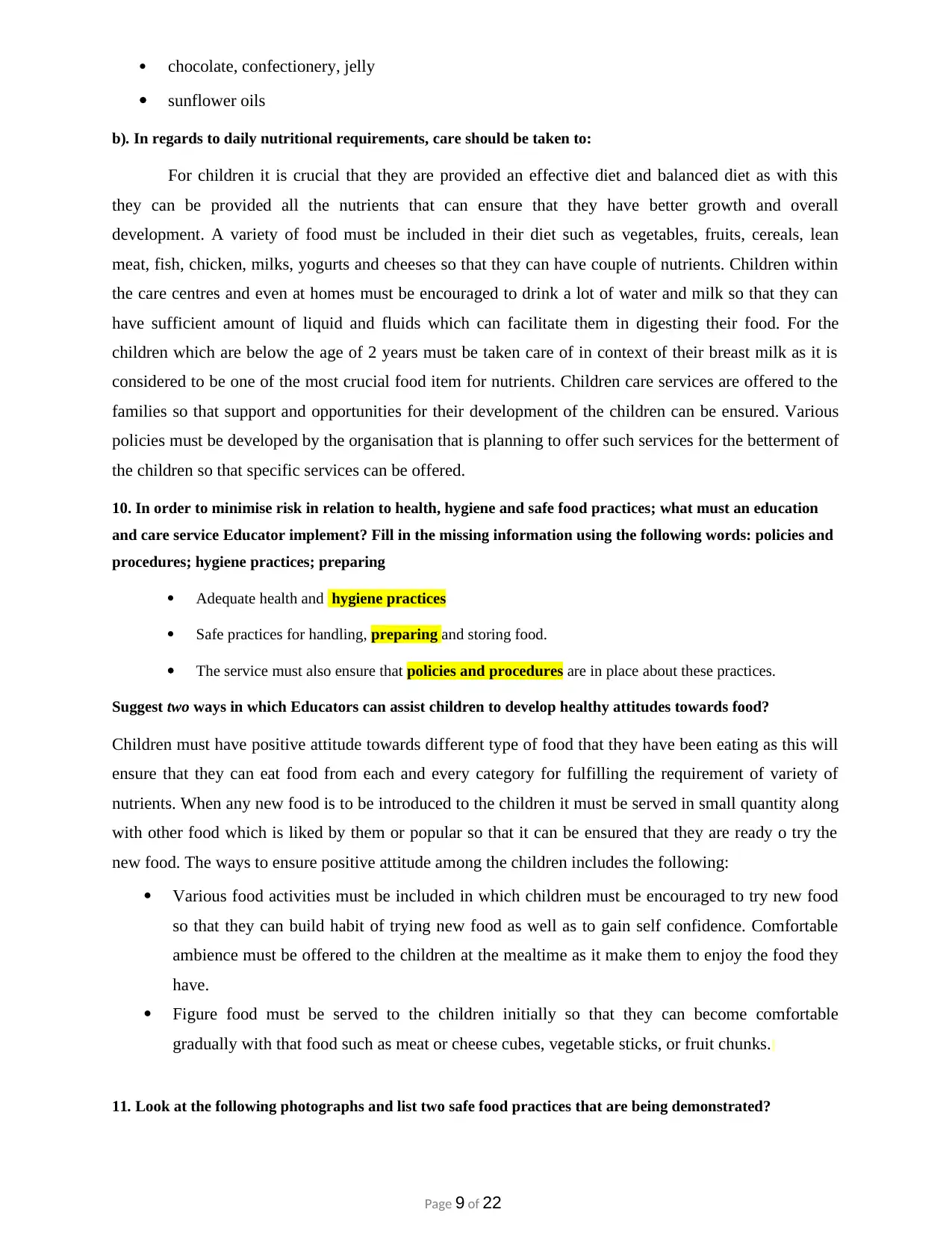
chocolate, confectionery, jelly
sunflower oils
b). In regards to daily nutritional requirements, care should be taken to:
For children it is crucial that they are provided an effective diet and balanced diet as with this
they can be provided all the nutrients that can ensure that they have better growth and overall
development. A variety of food must be included in their diet such as vegetables, fruits, cereals, lean
meat, fish, chicken, milks, yogurts and cheeses so that they can have couple of nutrients. Children within
the care centres and even at homes must be encouraged to drink a lot of water and milk so that they can
have sufficient amount of liquid and fluids which can facilitate them in digesting their food. For the
children which are below the age of 2 years must be taken care of in context of their breast milk as it is
considered to be one of the most crucial food item for nutrients. Children care services are offered to the
families so that support and opportunities for their development of the children can be ensured. Various
policies must be developed by the organisation that is planning to offer such services for the betterment of
the children so that specific services can be offered.
10. In order to minimise risk in relation to health, hygiene and safe food practices; what must an education
and care service Educator implement? Fill in the missing information using the following words: policies and
procedures; hygiene practices; preparing
Adequate health and hygiene practices
Safe practices for handling, preparing and storing food.
The service must also ensure that policies and procedures are in place about these practices.
Suggest two ways in which Educators can assist children to develop healthy attitudes towards food?
Children must have positive attitude towards different type of food that they have been eating as this will
ensure that they can eat food from each and every category for fulfilling the requirement of variety of
nutrients. When any new food is to be introduced to the children it must be served in small quantity along
with other food which is liked by them or popular so that it can be ensured that they are ready o try the
new food. The ways to ensure positive attitude among the children includes the following:
Various food activities must be included in which children must be encouraged to try new food
so that they can build habit of trying new food as well as to gain self confidence. Comfortable
ambience must be offered to the children at the mealtime as it make them to enjoy the food they
have.
Figure food must be served to the children initially so that they can become comfortable
gradually with that food such as meat or cheese cubes, vegetable sticks, or fruit chunks.
11. Look at the following photographs and list two safe food practices that are being demonstrated?
Page 9 of 22
sunflower oils
b). In regards to daily nutritional requirements, care should be taken to:
For children it is crucial that they are provided an effective diet and balanced diet as with this
they can be provided all the nutrients that can ensure that they have better growth and overall
development. A variety of food must be included in their diet such as vegetables, fruits, cereals, lean
meat, fish, chicken, milks, yogurts and cheeses so that they can have couple of nutrients. Children within
the care centres and even at homes must be encouraged to drink a lot of water and milk so that they can
have sufficient amount of liquid and fluids which can facilitate them in digesting their food. For the
children which are below the age of 2 years must be taken care of in context of their breast milk as it is
considered to be one of the most crucial food item for nutrients. Children care services are offered to the
families so that support and opportunities for their development of the children can be ensured. Various
policies must be developed by the organisation that is planning to offer such services for the betterment of
the children so that specific services can be offered.
10. In order to minimise risk in relation to health, hygiene and safe food practices; what must an education
and care service Educator implement? Fill in the missing information using the following words: policies and
procedures; hygiene practices; preparing
Adequate health and hygiene practices
Safe practices for handling, preparing and storing food.
The service must also ensure that policies and procedures are in place about these practices.
Suggest two ways in which Educators can assist children to develop healthy attitudes towards food?
Children must have positive attitude towards different type of food that they have been eating as this will
ensure that they can eat food from each and every category for fulfilling the requirement of variety of
nutrients. When any new food is to be introduced to the children it must be served in small quantity along
with other food which is liked by them or popular so that it can be ensured that they are ready o try the
new food. The ways to ensure positive attitude among the children includes the following:
Various food activities must be included in which children must be encouraged to try new food
so that they can build habit of trying new food as well as to gain self confidence. Comfortable
ambience must be offered to the children at the mealtime as it make them to enjoy the food they
have.
Figure food must be served to the children initially so that they can become comfortable
gradually with that food such as meat or cheese cubes, vegetable sticks, or fruit chunks.
11. Look at the following photographs and list two safe food practices that are being demonstrated?
Page 9 of 22
⊘ This is a preview!⊘
Do you want full access?
Subscribe today to unlock all pages.

Trusted by 1+ million students worldwide
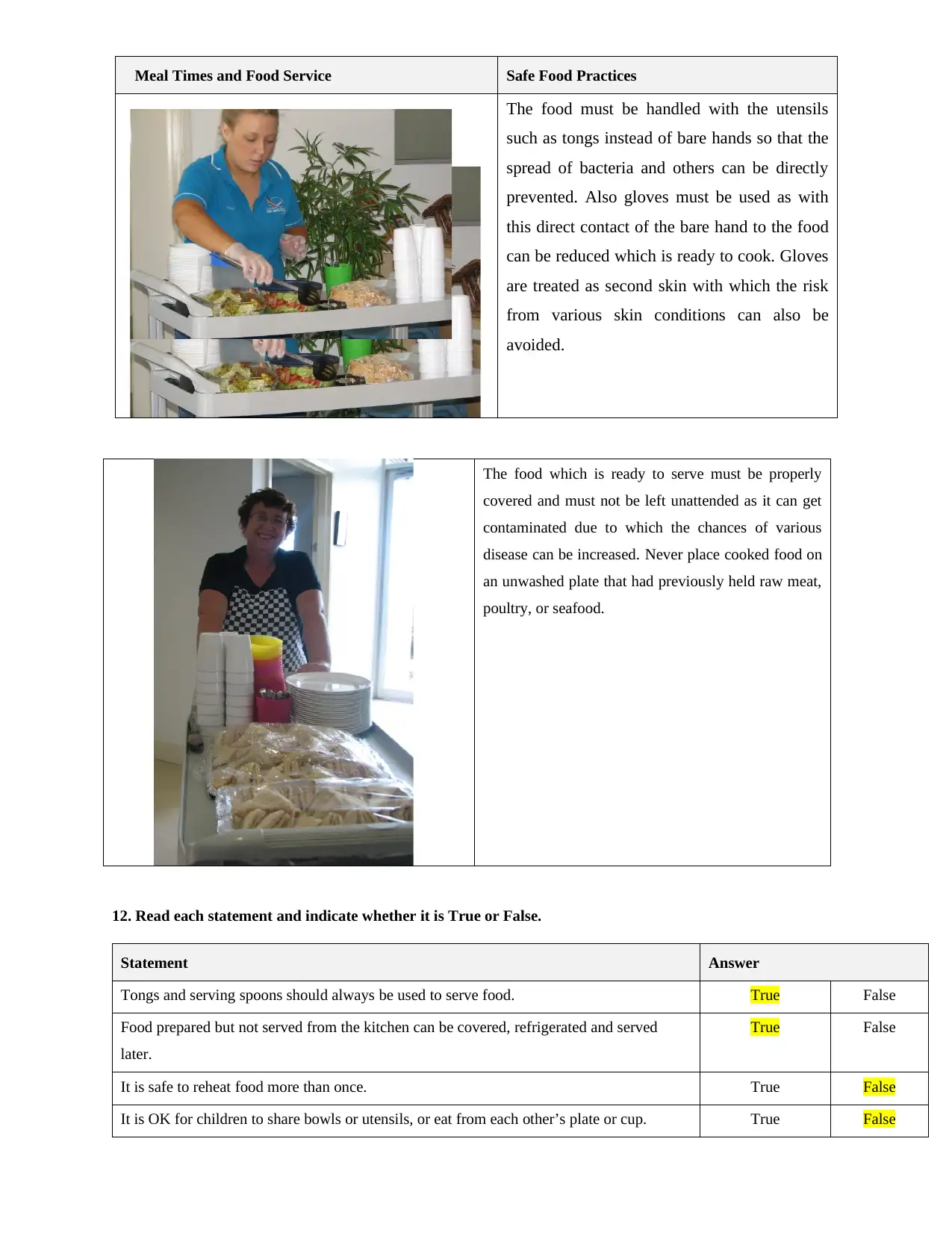
Meal Times and Food Service Safe Food Practices
The food must be handled with the utensils
such as tongs instead of bare hands so that the
spread of bacteria and others can be directly
prevented. Also gloves must be used as with
this direct contact of the bare hand to the food
can be reduced which is ready to cook. Gloves
are treated as second skin with which the risk
from various skin conditions can also be
avoided.
The food which is ready to serve must be properly
covered and must not be left unattended as it can get
contaminated due to which the chances of various
disease can be increased. Never place cooked food on
an unwashed plate that had previously held raw meat,
poultry, or seafood.
12. Read each statement and indicate whether it is True or False.
Statement Answer
Tongs and serving spoons should always be used to serve food. True False
Food prepared but not served from the kitchen can be covered, refrigerated and served
later.
True False
It is safe to reheat food more than once. True False
It is OK for children to share bowls or utensils, or eat from each other’s plate or cup. True False
The food must be handled with the utensils
such as tongs instead of bare hands so that the
spread of bacteria and others can be directly
prevented. Also gloves must be used as with
this direct contact of the bare hand to the food
can be reduced which is ready to cook. Gloves
are treated as second skin with which the risk
from various skin conditions can also be
avoided.
The food which is ready to serve must be properly
covered and must not be left unattended as it can get
contaminated due to which the chances of various
disease can be increased. Never place cooked food on
an unwashed plate that had previously held raw meat,
poultry, or seafood.
12. Read each statement and indicate whether it is True or False.
Statement Answer
Tongs and serving spoons should always be used to serve food. True False
Food prepared but not served from the kitchen can be covered, refrigerated and served
later.
True False
It is safe to reheat food more than once. True False
It is OK for children to share bowls or utensils, or eat from each other’s plate or cup. True False
Paraphrase This Document
Need a fresh take? Get an instant paraphrase of this document with our AI Paraphraser
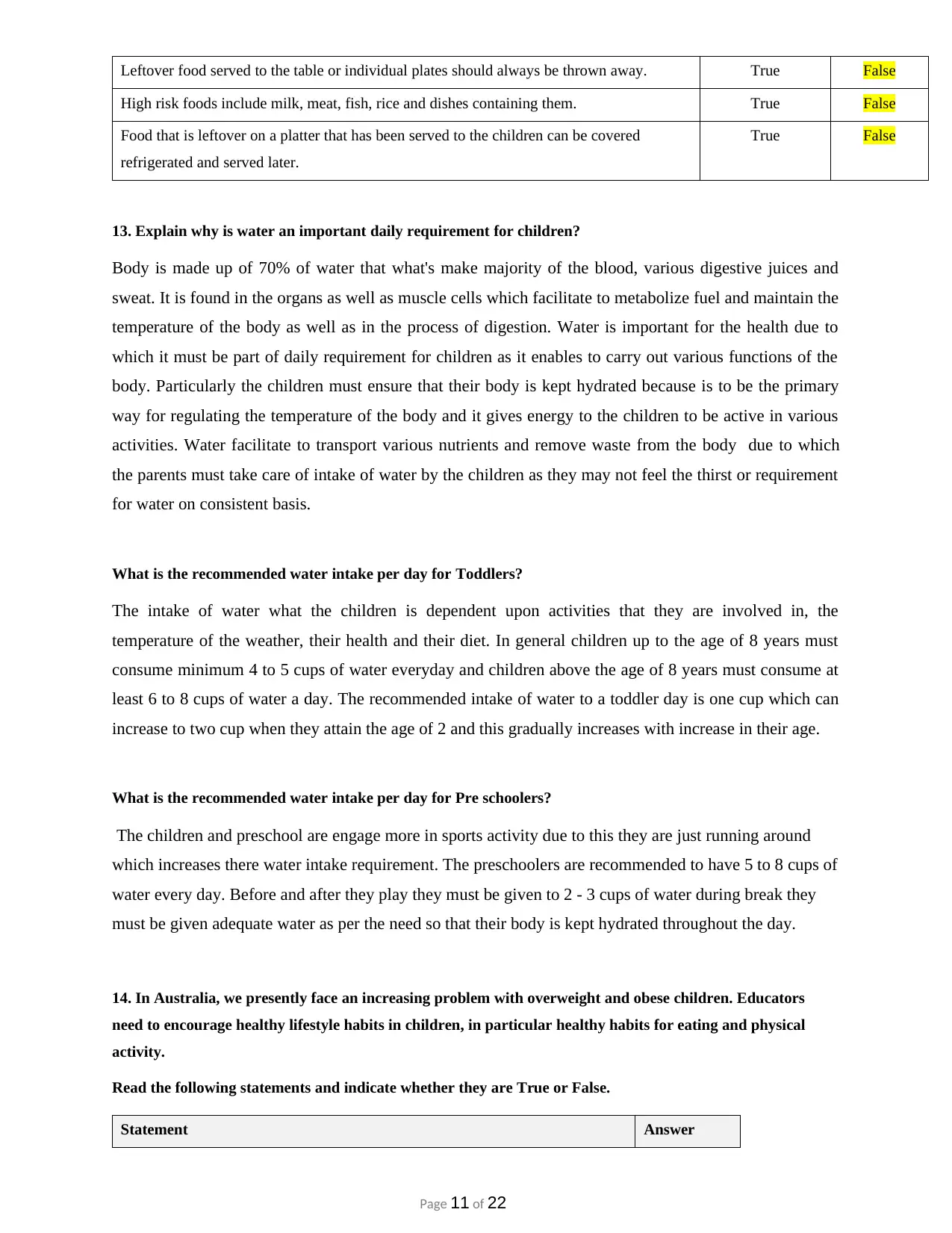
Leftover food served to the table or individual plates should always be thrown away. True False
High risk foods include milk, meat, fish, rice and dishes containing them. True False
Food that is leftover on a platter that has been served to the children can be covered
refrigerated and served later.
True False
13. Explain why is water an important daily requirement for children?
Body is made up of 70% of water that what's make majority of the blood, various digestive juices and
sweat. It is found in the organs as well as muscle cells which facilitate to metabolize fuel and maintain the
temperature of the body as well as in the process of digestion. Water is important for the health due to
which it must be part of daily requirement for children as it enables to carry out various functions of the
body. Particularly the children must ensure that their body is kept hydrated because is to be the primary
way for regulating the temperature of the body and it gives energy to the children to be active in various
activities. Water facilitate to transport various nutrients and remove waste from the body due to which
the parents must take care of intake of water by the children as they may not feel the thirst or requirement
for water on consistent basis.
What is the recommended water intake per day for Toddlers?
The intake of water what the children is dependent upon activities that they are involved in, the
temperature of the weather, their health and their diet. In general children up to the age of 8 years must
consume minimum 4 to 5 cups of water everyday and children above the age of 8 years must consume at
least 6 to 8 cups of water a day. The recommended intake of water to a toddler day is one cup which can
increase to two cup when they attain the age of 2 and this gradually increases with increase in their age.
What is the recommended water intake per day for Pre schoolers?
The children and preschool are engage more in sports activity due to this they are just running around
which increases there water intake requirement. The preschoolers are recommended to have 5 to 8 cups of
water every day. Before and after they play they must be given to 2 - 3 cups of water during break they
must be given adequate water as per the need so that their body is kept hydrated throughout the day.
14. In Australia, we presently face an increasing problem with overweight and obese children. Educators
need to encourage healthy lifestyle habits in children, in particular healthy habits for eating and physical
activity.
Read the following statements and indicate whether they are True or False.
Statement Answer
Page 11 of 22
High risk foods include milk, meat, fish, rice and dishes containing them. True False
Food that is leftover on a platter that has been served to the children can be covered
refrigerated and served later.
True False
13. Explain why is water an important daily requirement for children?
Body is made up of 70% of water that what's make majority of the blood, various digestive juices and
sweat. It is found in the organs as well as muscle cells which facilitate to metabolize fuel and maintain the
temperature of the body as well as in the process of digestion. Water is important for the health due to
which it must be part of daily requirement for children as it enables to carry out various functions of the
body. Particularly the children must ensure that their body is kept hydrated because is to be the primary
way for regulating the temperature of the body and it gives energy to the children to be active in various
activities. Water facilitate to transport various nutrients and remove waste from the body due to which
the parents must take care of intake of water by the children as they may not feel the thirst or requirement
for water on consistent basis.
What is the recommended water intake per day for Toddlers?
The intake of water what the children is dependent upon activities that they are involved in, the
temperature of the weather, their health and their diet. In general children up to the age of 8 years must
consume minimum 4 to 5 cups of water everyday and children above the age of 8 years must consume at
least 6 to 8 cups of water a day. The recommended intake of water to a toddler day is one cup which can
increase to two cup when they attain the age of 2 and this gradually increases with increase in their age.
What is the recommended water intake per day for Pre schoolers?
The children and preschool are engage more in sports activity due to this they are just running around
which increases there water intake requirement. The preschoolers are recommended to have 5 to 8 cups of
water every day. Before and after they play they must be given to 2 - 3 cups of water during break they
must be given adequate water as per the need so that their body is kept hydrated throughout the day.
14. In Australia, we presently face an increasing problem with overweight and obese children. Educators
need to encourage healthy lifestyle habits in children, in particular healthy habits for eating and physical
activity.
Read the following statements and indicate whether they are True or False.
Statement Answer
Page 11 of 22
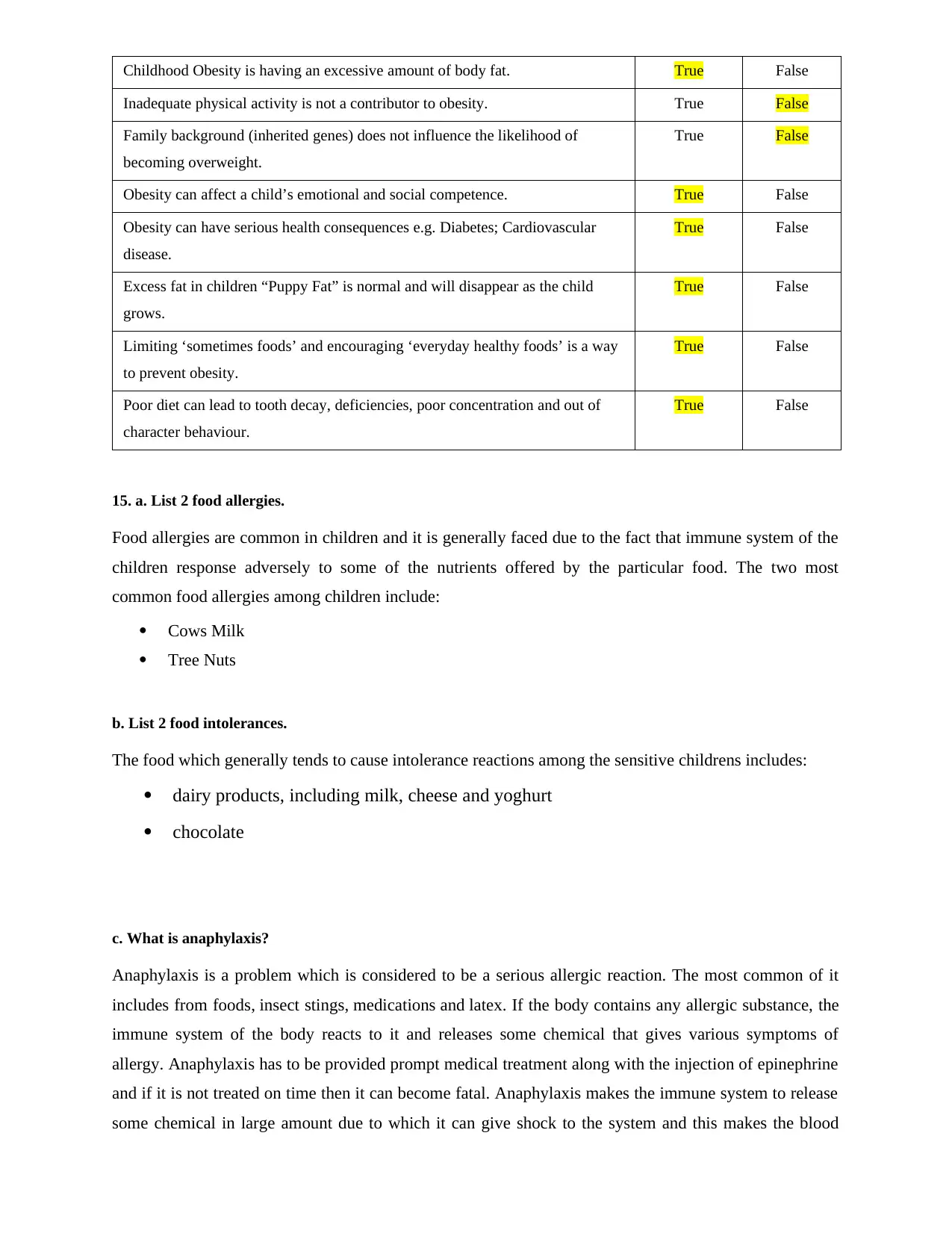
Childhood Obesity is having an excessive amount of body fat. True False
Inadequate physical activity is not a contributor to obesity. True False
Family background (inherited genes) does not influence the likelihood of
becoming overweight.
True False
Obesity can affect a child’s emotional and social competence. True False
Obesity can have serious health consequences e.g. Diabetes; Cardiovascular
disease.
True False
Excess fat in children “Puppy Fat” is normal and will disappear as the child
grows.
True False
Limiting ‘sometimes foods’ and encouraging ‘everyday healthy foods’ is a way
to prevent obesity.
True False
Poor diet can lead to tooth decay, deficiencies, poor concentration and out of
character behaviour.
True False
15. a. List 2 food allergies.
Food allergies are common in children and it is generally faced due to the fact that immune system of the
children response adversely to some of the nutrients offered by the particular food. The two most
common food allergies among children include:
Cows Milk
Tree Nuts
b. List 2 food intolerances.
The food which generally tends to cause intolerance reactions among the sensitive childrens includes:
dairy products, including milk, cheese and yoghurt
chocolate
c. What is anaphylaxis?
Anaphylaxis is a problem which is considered to be a serious allergic reaction. The most common of it
includes from foods, insect stings, medications and latex. If the body contains any allergic substance, the
immune system of the body reacts to it and releases some chemical that gives various symptoms of
allergy. Anaphylaxis has to be provided prompt medical treatment along with the injection of epinephrine
and if it is not treated on time then it can become fatal. Anaphylaxis makes the immune system to release
some chemical in large amount due to which it can give shock to the system and this makes the blood
Inadequate physical activity is not a contributor to obesity. True False
Family background (inherited genes) does not influence the likelihood of
becoming overweight.
True False
Obesity can affect a child’s emotional and social competence. True False
Obesity can have serious health consequences e.g. Diabetes; Cardiovascular
disease.
True False
Excess fat in children “Puppy Fat” is normal and will disappear as the child
grows.
True False
Limiting ‘sometimes foods’ and encouraging ‘everyday healthy foods’ is a way
to prevent obesity.
True False
Poor diet can lead to tooth decay, deficiencies, poor concentration and out of
character behaviour.
True False
15. a. List 2 food allergies.
Food allergies are common in children and it is generally faced due to the fact that immune system of the
children response adversely to some of the nutrients offered by the particular food. The two most
common food allergies among children include:
Cows Milk
Tree Nuts
b. List 2 food intolerances.
The food which generally tends to cause intolerance reactions among the sensitive childrens includes:
dairy products, including milk, cheese and yoghurt
chocolate
c. What is anaphylaxis?
Anaphylaxis is a problem which is considered to be a serious allergic reaction. The most common of it
includes from foods, insect stings, medications and latex. If the body contains any allergic substance, the
immune system of the body reacts to it and releases some chemical that gives various symptoms of
allergy. Anaphylaxis has to be provided prompt medical treatment along with the injection of epinephrine
and if it is not treated on time then it can become fatal. Anaphylaxis makes the immune system to release
some chemical in large amount due to which it can give shock to the system and this makes the blood
⊘ This is a preview!⊘
Do you want full access?
Subscribe today to unlock all pages.

Trusted by 1+ million students worldwide
1 out of 22
Your All-in-One AI-Powered Toolkit for Academic Success.
+13062052269
info@desklib.com
Available 24*7 on WhatsApp / Email
![[object Object]](/_next/static/media/star-bottom.7253800d.svg)
Unlock your academic potential
Copyright © 2020–2025 A2Z Services. All Rights Reserved. Developed and managed by ZUCOL.
